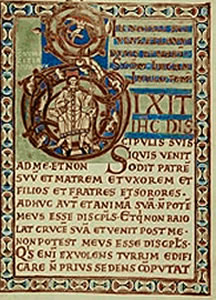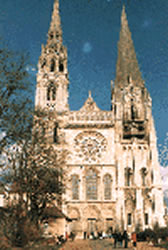Art History
Medieval Times
373 to 1453 AD After the fall of the Roman Empire, the only stable organization left in Western Europe was the church. It’s influence was felt everywhere, and it gave the medieval period its special character. The church saw that art could be used to inspire and teach its followers. Since most people couldn't read, they had to rely on visual images. A limited number of handwritten books were produced for those few who could read, but the illustrations drawn and painted in these books were intended for the majority of people who couldn't read. The carvings on the facade or front of medieval churches also expressed religious teachings.
After the fall of the Roman Empire, the only stable organization left in Western Europe was the church. It’s influence was felt everywhere, and it gave the medieval period its special character. The church saw that art could be used to inspire and teach its followers. Since most people couldn't read, they had to rely on visual images. A limited number of handwritten books were produced for those few who could read, but the illustrations drawn and painted in these books were intended for the majority of people who couldn't read. The carvings on the facade or front of medieval churches also expressed religious teachings. The task of teaching and spreading the faith belonged to monks. They were dedicated men living together under a strict set of rules in religious communities called Monasteries. There were no printing presses during the medieval period, so all books had to be copied painstakingly by hand. Monks who did this copying were often artists of great skill. They took pride in making beautifully proportioned letters and adding graceful miniature drawings.
ROMANESQUE ART (1000 to 1500 AD)
Miniature drawing and painting in religious manuscripts started in early Christian times and became more
 popular during the early medieval period. It continued to be an important artistic activity throughout Western Europe during the Romanesque period. The art of the early medieval period had been local, rarely reaching beyond the surrounding community. Romanesque art, however, gradually became more international in character. This international character resulted from the exchange of ideas due to the growth in trade and travel during the eleventh and twelfth centuries. Romanesque paintings and drawings have a flat, two-dimensional look. Their brightly colored and richly patterned figures and objects look like they were cut from cardboard and laid one on top of the other. Romanesque artists made little effort to make their pictures look realistic. Instead, they used colorful shapes and dark lines to illustrate traditional religious stories. A glance at one of these illustrations quickly brought the story to the viewer's mind. Then the viewer could meditate on the meaning of that story.
popular during the early medieval period. It continued to be an important artistic activity throughout Western Europe during the Romanesque period. The art of the early medieval period had been local, rarely reaching beyond the surrounding community. Romanesque art, however, gradually became more international in character. This international character resulted from the exchange of ideas due to the growth in trade and travel during the eleventh and twelfth centuries. Romanesque paintings and drawings have a flat, two-dimensional look. Their brightly colored and richly patterned figures and objects look like they were cut from cardboard and laid one on top of the other. Romanesque artists made little effort to make their pictures look realistic. Instead, they used colorful shapes and dark lines to illustrate traditional religious stories. A glance at one of these illustrations quickly brought the story to the viewer's mind. Then the viewer could meditate on the meaning of that story.GOTHIC ART (1000 to 1500 AD)
 At no other period in history were the visual arts so closely joined in a
At no other period in history were the visual arts so closely joined in a  common effort than in the Gothic period. Drawing, painting, sculpture, and architecture were combined to create the Gothic cathedral or church, which featured pointed arches and weight-bearing pillars. Walls were only required to enclose and define space, so artists began designing walls made of stained glass. The designs used for stained glass windows greatly influenced the style of drawing and painting used in manuscript illustrations. Gothic manuscript illustrations often showed slender, graceful religious figures in flowing costumes placed inside frames like those of cathedral windows. Solid gold backgrounds were used to emphasize the spiritual importance of the scenes.
common effort than in the Gothic period. Drawing, painting, sculpture, and architecture were combined to create the Gothic cathedral or church, which featured pointed arches and weight-bearing pillars. Walls were only required to enclose and define space, so artists began designing walls made of stained glass. The designs used for stained glass windows greatly influenced the style of drawing and painting used in manuscript illustrations. Gothic manuscript illustrations often showed slender, graceful religious figures in flowing costumes placed inside frames like those of cathedral windows. Solid gold backgrounds were used to emphasize the spiritual importance of the scenes. Tempera paintings on wooden panels used similar designs to decorate the altars inside churches. This elegant style of painting became so popular throughout Western Europe that it came to be known as the Gothic International style.
 Because the Gothic style of architecture didn't spread to Italy until later, Italian artists could still paint religious pictures on interior church walls. First, the artist made a charcoal drawing on the wall. Then a thin coat of plaster was applied, and the charcoal lines were traced. Paint mixed with water and egg whites was applied. This process gave the painting technique its name, fresco. The paint and wet plaster mixed together to form a permanent surface when they dried.
Because the Gothic style of architecture didn't spread to Italy until later, Italian artists could still paint religious pictures on interior church walls. First, the artist made a charcoal drawing on the wall. Then a thin coat of plaster was applied, and the charcoal lines were traced. Paint mixed with water and egg whites was applied. This process gave the painting technique its name, fresco. The paint and wet plaster mixed together to form a permanent surface when they dried. The painting had to be done quickly while the plaster was still wet. The technique required confidence, boldness, and skill. One extraordinary artist, Giotto di Bondone, had all of these traits. In his Madonna and Child , Giotto captured the love between mother and son.